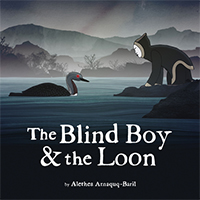| ________________
CM . . . . Volume XXI Number 23 . . . . February 20, 2015
excerpt:
Based on the award winning National Film Board of Canada animated short film, Lumaajuuq, this picture book is a haunting retelling of a traditional Inuit tale. In this version, a widowed mother takes out her grief and anger on her only son and treats him cruelly. Once a great hunter, the son is now blind. In the spring, he journeys to the lake where a loon speaks to him and reveals that it was his mother who cursed away his sight. With the loon's help, the young man regains his vision. Now consumed with anger, and "blinded by revenge", he causes his mother to be dragged into the sea while on a whale hunting expedition. Underwater, the mother transforms into a narwhal. The son's actions of retaliation result in a life of suffering. The moral of this origin tale is stated in the final sentence: "Today, the narwhal will forever be a reminder that every act of revenge is a link in a chain that can only be broken by forgiveness". Alethea Arnaquq-Baril's abbreviated version is deeply rooted in her Inuit storytelling cultural history. In an author's preface, she explains her initial trepidation with retelling "one of the most ancient and commonly told [stories] in Inuit history". Arnaquq-Baril states that this version of the epic story is her own, based on a combination of versions "heard over the years from different elders, ethnographers, and researchers". As in traditional fairy tales, the emotions explored in this book are dark, and the punishments meted out are harsh. Arnaquq-Baril's engaging writing style has a cinematic feel. The simply told, evocative images immediately capture readers' imaginations and will spark reflection and discussion. The dark, foreboding atmosphere of the text is perfectly enhanced by the accompanying animated cells from the National Film Board film. The pages are bathed in sombre shades of black, grey and deep blue. The characters' faces have an expressionless, mask like appearance. Background details also show the harshness of the winter landscape. The Blind Boy & the Loon, a thought provoking and authentic Inuit tale, is a welcome addition to school and public library collections. Recommended. Linda Ludke is a librarian in London, ON. Copyright © the Manitoba Library Association. Reproduction for personal use is permitted only if this copyright notice is maintained. Any other reproduction is prohibited without permission.
Next Review |
Table of Contents for This Issue
- February 20, 2015. |
